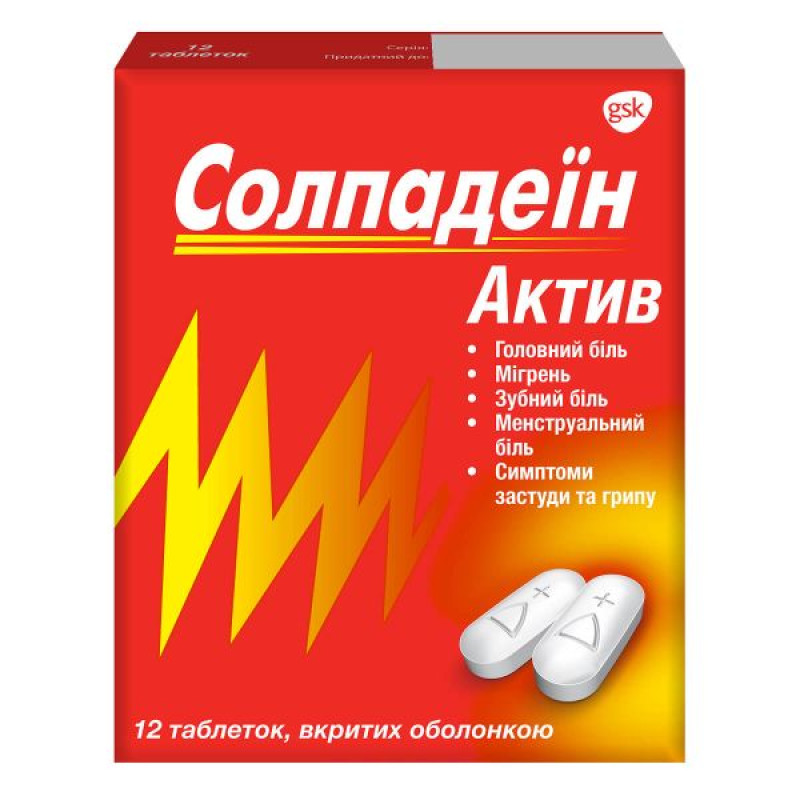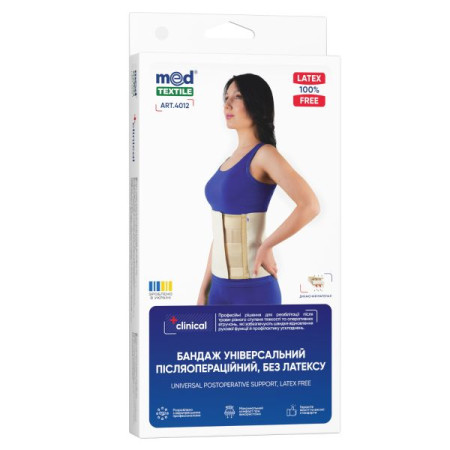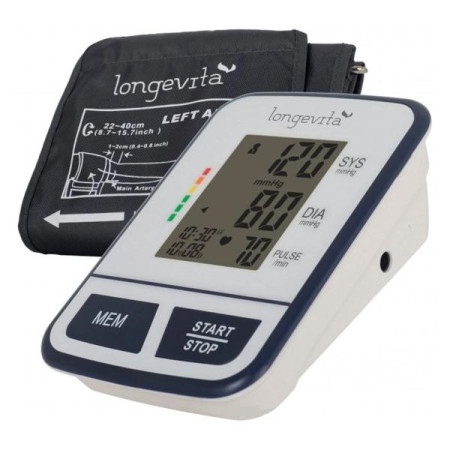Solpadeine Active film-coated tablets blister No. 12

Instructions Solpadeine Active film-coated tablets blister pack No. 12
Composition
active ingredients: 1 tablet contains 500 mg of paracetamol and 65 mg of caffeine;
Excipients: pregelatinized starch, corn starch, povidone, potassium sorbate, talc, stearic acid, croscarmellose sodium, hypromellose, glycerol triacetate.
Dosage form
Film-coated tablets.
Main physicochemical properties: white, capsule-shaped, film-coated tablets with flat edges, embossed with a triangular logo and a + symbol on one side and without embossing on the other side.
Pharmacotherapeutic group
Analgesics and antipyretics. Paracetamol, combinations without psycholeptics. ATX code N02B E51.
Pharmacological properties
Pharmacodynamics
Paracetamol is an analgesic-antipyretic. The effect is based on the inhibition of prostaglandin synthesis in the CNS. Due to the weak inhibition of peripheral prostaglandins, particularly in the gastrointestinal tract, paracetamol is partially suitable for patients for whom inhibition of peripheral prostaglandins is undesirable, for example when salicylates are contraindicated.
Caffeine acts as an enhancer, increasing the effectiveness of paracetamol.
Pharmacokinetics
Paracetamol and caffeine are rapidly absorbed from the gastrointestinal tract and distributed to most body tissues. Binding of paracetamol to plasma proteins is minimal at therapeutic doses.
Paracetamol and caffeine are metabolized mainly in the liver and excreted in the urine as transformation products.
Indication
The drug has a moderate analgesic and antipyretic effect. Indications for use are headache, including migraine, toothache, neuralgia, rheumatic pain, periodic pain in women; to relieve symptoms of colds and flu, sore throat.
Contraindication
Hypersensitivity to paracetamol, caffeine or any other component of the drug in history; severe liver and/or kidney disorders; congenital hyperbilirubinemia; glucose-6-phosphate dehydrogenase deficiency; alcoholism; blood diseases, severe anemia, leukopenia; states of increased excitement, sleep disorders, epilepsy; severe increased blood pressure, organic diseases of the cardiovascular system, including severe atherosclerosis, severe hypertension; decompensated heart failure, acute myocardial infarction, paroxysmal tachycardia, hyperthyroidism, acute pancreatitis, severe forms of diabetes mellitus, glaucoma; age over 60 years.
Do not use with monoamine oxidase inhibitors (MAOIs) and within 2 weeks of discontinuing MAOIs.
Contraindicated in patients taking tricyclic antidepressants or beta-blockers.
Interaction with other medicinal products and other types of interactions
The rate of absorption of paracetamol may be increased by metoclopramide and domperidone and decreased by cholestyramine.
Long-term simultaneous use of the drug with acetylsalicylic acid or other non-steroidal anti-inflammatory drugs may lead to kidney damage.
The anticoagulant effect of warfarin and other coumarins with an increased risk of bleeding may be enhanced by prolonged regular use of paracetamol. Single doses do not have a significant effect. Barbiturates reduce the antipyretic effect of paracetamol. Anticonvulsants (including phenytoin, barbiturates, carbamazepine), which stimulate the activity of liver microsomal enzymes, may enhance the toxic effect of paracetamol on the liver due to an increase in the degree of conversion of the drug to hepatotoxic metabolites. With simultaneous use of paracetamol with hepatotoxic drugs, the likelihood of accumulation of paracetamol increases, and the toxic effect of paracetamol and these drugs on the liver increases. Simultaneous use of high doses of paracetamol with isoniazid increases the risk of developing hepatotoxic syndrome. Paracetamol reduces the effectiveness of diuretics.
Paracetamol increases the plasma levels of acetylsalicylic acid and chloramphenicol. Probenecid affects the plasma concentration of paracetamol and its excretion.
Inducers of liver microsomal enzymes (rifampicin and phenobarbital) increase the toxicity of paracetamol, since its biotransformation produces a large amount of toxic epoxide. Paracetamol may reduce the bioavailability of lamotrigine, thereby reducing its effect, due to the possible induction of its metabolism in the liver. With the simultaneous use of paracetamol and zidovudine, the risk of neutropenia increases.
Do not use simultaneously with alcohol.
The simultaneous use of caffeine with MAO inhibitors can cause a dangerous increase in blood pressure. Caffeine enhances the effect (improves bioavailability) of analgesics-antipyretics, potentiates the effects of xanthine derivatives, alpha- and beta-adrenomimetics, and psychostimulants.
Caffeine reduces the effect of opioid analgesics, anxiolytics, hypnotics and sedatives, is an antagonist of anesthetics and other drugs that depress the central nervous system, a competitive antagonist of adenosine drugs, ATP. When caffeine is used simultaneously with ergotamine, the absorption of ergotamine from the gastrointestinal tract improves, and with thyroid-stimulating drugs, the thyroid effect increases.
Caffeine may increase the excretion of lithium from the body. Therefore, simultaneous use of the drug with lithium preparations is not recommended.
Application features
The product contains paracetamol, so it should not be used with other paracetamol-containing products used, for example, to reduce fever, treat pain, flu and cold symptoms or insomnia. Simultaneous use with other paracetamol-containing products may lead to overdose. Paracetamol overdose may cause liver failure, which may require a liver transplant or be fatal.
In case of liver or kidney diseases, you should consult a doctor before using the drug. Restrictions on the use of the drug in such patients are primarily due to the paracetamol content. In patients with liver diseases, the risk of hepatotoxic effects of paracetamol increases.
Alcoholic beverages should not be consumed during treatment. Paracetamol may be toxic to the liver at doses exceeding 6–8 g per day. However, adverse effects on the liver may occur at much lower doses in the case of alcohol consumption, the use of inducers of liver enzymes or other substances that have a toxic effect on the liver, as well as in patients with non-cirrhotic alcoholic liver disease. Long-term use of alcohol significantly increases the risk of developing hepatotoxic effects of paracetamol. In patients with impaired liver function, as well as in those taking large doses of paracetamol for a long time, regular liver function tests are recommended.
When treating with oral anticoagulants with simultaneous administration of large doses of paracetamol, monitoring of prothrombin time is necessary.
The drug may affect the results of laboratory tests for blood glucose and uric acid. Patients who take analgesics every day for mild arthritis should consult a doctor before use.
Cases of liver dysfunction/liver failure have been reported in patients with reduced glutathione levels, such as those with severe wasting, anorexia, low body mass index, chronic alcoholism, or sepsis.
Patients with reduced glutathione levels are at increased risk of metabolic acidosis when taking paracetamol. Symptoms of metabolic acidosis include deep, rapid or labored breathing, nausea, vomiting, and loss of appetite. You should seek immediate medical attention if these symptoms occur.
If symptoms persist, you should consult a doctor.
During treatment with the drug, it is not recommended to consume excessive amounts of beverages containing caffeine (such as coffee, tea and some other drinks). This may lead to sleep problems, tremors, chest discomfort due to palpitations, tension, irritability.
Keep the drug out of the sight and reach of children.
Ability to influence reaction speed when driving vehicles or other mechanisms
The impact is absent or insignificant.
Use during pregnancy or breastfeeding
It is not recommended to use the drug during pregnancy, as the risk of spontaneous miscarriage associated with caffeine use is increased.
It is not recommended to use the drug during breastfeeding. Paracetamol and caffeine penetrate into breast milk, but in clinically insignificant quantities (when taken in recommended doses). Caffeine in breast milk may have a stimulating effect on infants during breastfeeding, but no significant toxicity has been observed.
Method of administration and doses
The drug is intended for oral use.
Adults and children over 12 years: 1–2 tablets every 4–6 hours as needed. Do not take more than 8 tablets (4000 mg paracetamol/520 mg caffeine) in 24 hours.
Do not exceed the recommended dose.
The lowest dose of the drug should be used for the shortest period of time necessary to obtain a therapeutic effect.
The interval between doses should be at least 4 hours.
Children
The drug is not recommended for children under 12 years of age.
Overdose
Paracetamol overdose can cause liver failure, which may require liver transplantation or be fatal. Acute pancreatitis, usually accompanied by liver function abnormalities and hepatotoxicity, has been reported. Liver damage is possible in adults who have taken 6–8 g or more of paracetamol, and in children who have taken more than 150 mg/kg of body weight. In patients with risk factors (long-term treatment with carbamazepine, phenobarbitone, phenytoin, primidone, rifampicin, St. John's wort or other drugs that induce liver enzymes; regular intake of excessive amounts of ethanol; glutathione cachexia (digestive disorders, cystic fibrosis, HIV infection, starvation, cachexia)), taking 5 g or more of paracetamol can lead to liver damage.
In case of overdose, urgent medical attention is required. Treatment should be started immediately. The patient should be taken to a hospital, even if there are no early symptoms of overdose.
Symptoms of overdose in the first 24 hours: pallor, nausea, vomiting, loss of appetite and abdominal pain. Experience shows that clinical symptoms of liver damage usually become noticeable 24–48 hours after overdose and usually reach a maximum after 4–6 days. Glucose metabolism disorders and metabolic acidosis may occur. In severe poisoning, liver failure may progress to encephalopathy, hemorrhage, hypoglycemia, coma and be fatal. Acute renal failure with acute tubular necrosis may manifest as severe lumbar pain, hematuria, proteinuria and develop even in the absence of severe liver damage. Cardiac arrhythmias have also been noted.
With prolonged use of the drug in high doses, aplastic anemia, pancytopenia, agranulocytosis, neutropenia, leukopenia, thrombocytopenia may develop from the hematopoietic system. When taking large doses, dizziness, psychomotor agitation and disorientation are possible from the central nervous system; nephrotoxicity (renal colic, interstitial nephritis, capillary necrosis) is possible from the urinary system.
Symptoms of overdose may be limited to nausea and vomiting or may not reflect the severity of the overdose or the risk of organ damage. Immediate medical attention is necessary in case of overdose, even if symptoms of overdose are not observed. If overdose is confirmed or even suspected, the patient should be taken to the nearest medical facility where emergency medical care and qualified treatment can be provided. This should be done even if symptoms of overdose are absent, because of the risk of delayed liver damage. Treatment with activated charcoal should be considered if an overdose of paracetamol has been taken within 1 hour. The concentration of paracetamol in the blood plasma should be measured 4 hours or later after ingestion (earlier concentrations are unreliable). Treatment with N-acetylcysteine can be used within 24 hours of ingestion of paracetamol, but the maximum protective effect occurs when it is used within 8 hours of ingestion. The effectiveness of the antidote decreases sharply after this time. If necessary, the patient should be given intravenous N-acetylcysteine at the recommended dosage. In the absence of vomiting, oral methionine may be used as a suitable alternative in remote areas outside the hospital.
Caffeine.
Caffeine overdose can cause epigastric pain, vomiting, diuresis, rapid breathing, tachycardia or cardiac arrhythmia, and affect the central nervous system (insomnia, restlessness, nervous excitement, agitation, anxiety, dizziness, irritability, affective state, tremor, convulsions). Clinically important symptoms of caffeine overdose are also associated with serious liver damage by paracetamol, which can occur when large amounts of the drug are taken. There is no specific antidote, but supportive measures, such as the use of beta-adrenoreceptor antagonists, can alleviate the cardiotoxic effect. Gastric lavage is necessary, oxygen therapy is recommended, and diazepam is recommended for convulsions. Symptomatic therapy.
Adverse reactions
The following adverse reactions have been reported from post-marketing experience. The data are provided voluntarily and relate to a patient population of unknown size, therefore the frequency of these adverse reactions is unknown and is likely to be rare (< 1/10,000).
Adverse reactions caused by paracetamol:
From the blood and lymphatic system: thrombocytopenia, neutropenia, leukopenia, agranulocytosis, pancytopenia.
Immune system disorders: anaphylaxis, cutaneous hypersensitivity reactions including skin rash, angioedema, Stevens-Johnson syndrome, toxic epidermal necrolysis and acute generalized exanthematous pustulosis.
Respiratory, thoracic and mediastinal disorders: bronchospasm in patients sensitive to acetylsalicylic acid and other non-steroidal anti-inflammatory drugs.
From the hepatobiliary system: liver dysfunction, liver failure, liver necrosis, jaundice.
Adverse reactions caused by caffeine:
From the side of the central nervous system: nervousness, dizziness.
Gastrointestinal: gastrointestinal upset, abdominal pain, diarrhea, nausea, vomiting.
On the part of the psyche: insomnia, restlessness, anxiety and irritability, nervousness.
Skin and subcutaneous tissue disorders: itching, rash, sweating, purpura, urticaria.
Also, after taking drugs containing similar active ingredients, the following side effects are possible: headache, erythema multiforme exudative, heartburn, epigastric pain, hypoglycemia, up to hypoglycemic coma, anemia, sulfhemoglobinemia and methemoglobinemia (cyanosis, shortness of breath, heart pain), hemolytic anemia, bruising or bleeding, tachycardia, arrhythmia, increased blood pressure, increased activity of liver enzymes, usually without the development of jaundice.
When the drug is taken at recommended doses with products containing caffeine, the increased dose of caffeine resulting in this way may increase caffeine-induced side effects.
Expiration date
4 years.
Storage conditions
Store at a temperature not exceeding 25 ºС, out of the reach and sight of children.
Packaging
12 film-coated tablets in a blister, 1 blister in a cardboard box.
Vacation category
Without a prescription.
Producer
GlaxoSmithKline Dungarvan Limited.
Location of the manufacturer and its business address
Knockbrake, Dungarvan, County Waterford, Ireland.
There are no reviews for this product.
There are no reviews for this product, be the first to leave your review.
No questions about this product, be the first and ask your question.













